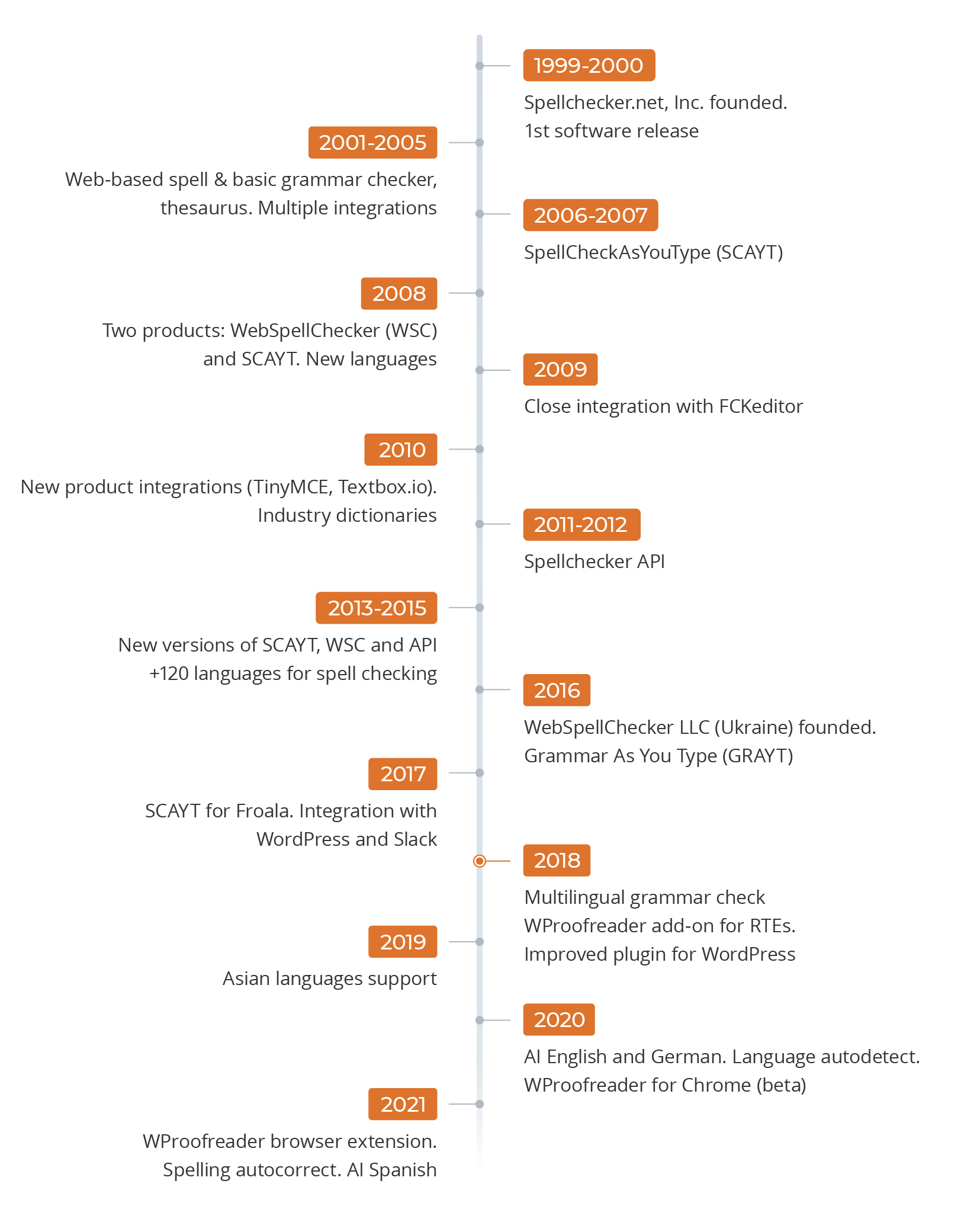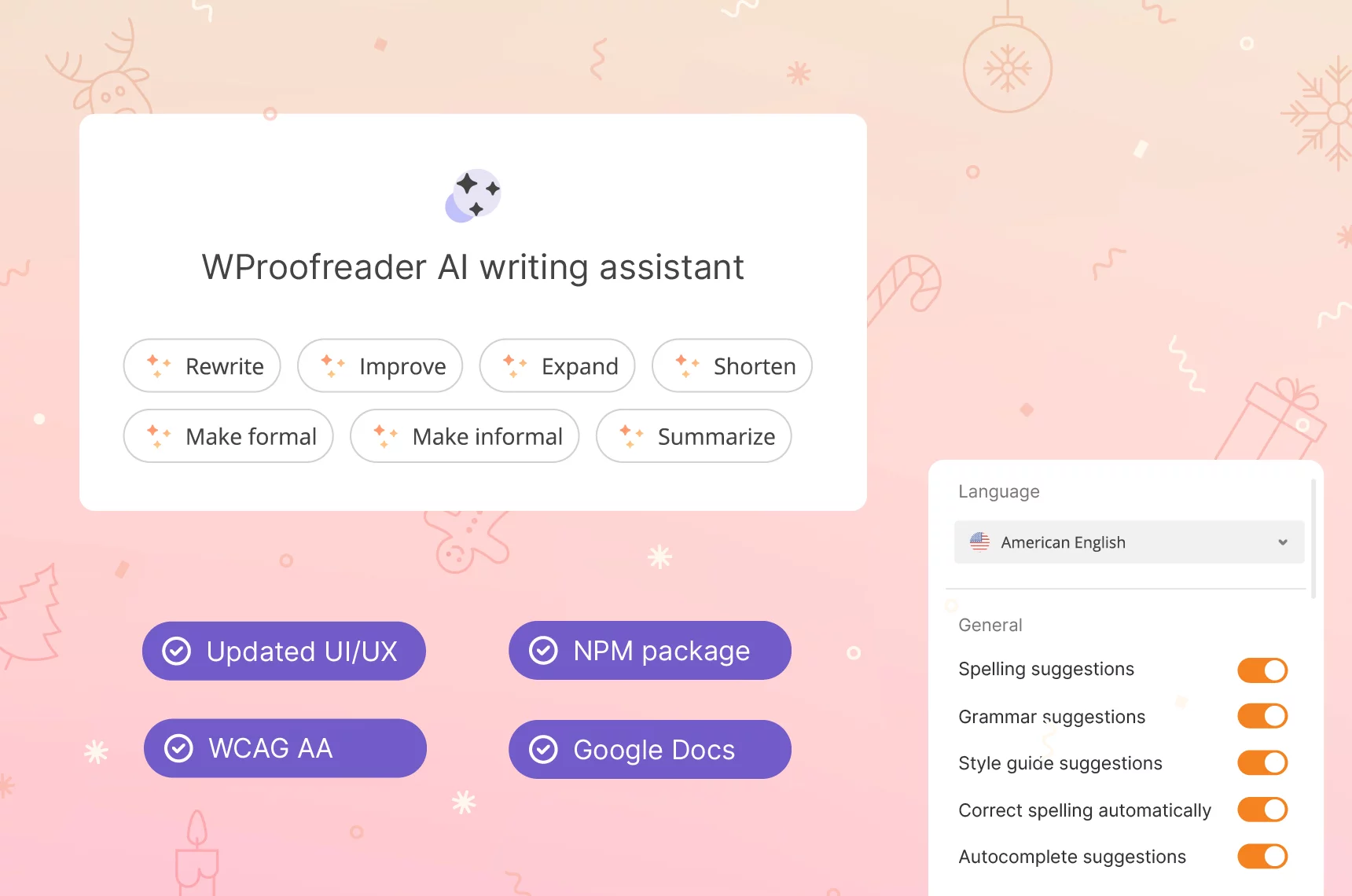2019. The Washington Post publishes the article “People do grammar bad. Google’s AI is hear too help.”
The piece collected 200+ comments of irritated users blaming AI spelling and grammar checkers for “terrible and annoying autocorrect”, “giving many false positives and negatives”, “creating confusion”, “feeling stilted and robotic”…
The coin always has two sides. Yes, in-browser spell check and grammar check extensions aren’t ideal, they tend to fail and do it often.
But the good thing is that they’re evolving (like everything on the Earth) and the new generation of text proofreaders are smarter and more prolific.
Give this article five minutes, and we’ll give you proof that AI grammar checkers do their job great. So, the next time, you may want to stand up for them rather than going against them.
A sneak peek into the history of AI grammar checkers
The history of text checkers is long and adventurous. It started with SPELL for the DEC PDP-10 application program, written in assembly language.
Then there were text checkers built into word-processing packages like WordStar and WordPerfect, Oracle’s short-lived CoAuthor and Microsoft Word’s famous native text checker. Who didn’t use it?
With the development of the web and browsers, a new cohort of online text checkers appeared. The first were WebSpellChecker, LanguageTool, Ginger.
Then came Grammarly and ProWritingAid and, finally, Linguix and Sapling AI.
This new generation of spell and grammar checkers is smarter, more accurate, and better solves
proofreading tasks
20 and even 10 years ago, text checkers weren’t available as in-browser extensions or as plug-ins for Microsoft Word or mobile keyboards.
They came as plug-ins and libraries for devs (WebSpellChecker), others were web pages for instant online text check (Grammarly). Their engines were rules-based, deployed n-grams and language models patterns.
Some of them are still there, while others have made a leapfrog. They’ve switched to deep learning, which revolutionized the natural language processing domain.
A time-back machine: in early 2000s WebSpellChecker was a web-based spell & grammar checker, and thesaurus. Now it’s a powerful portfolio of AI spelling and grammar solutions.

This new generation of spell and grammar checkers is smarter, more accurate, and better solves proofreading tasks… and this is everything you can read on their official websites.
Magic words like AI-powered, machine learning, neural networks, algorithms sound bright, but don’t deliver much understanding.
Curious users flood Q&A platforms in the quest of holy grail — the secret technology of solutions similar to Grammarly AI .
What is the extending AI approach? And why in the world do I believe that these tricky things will work by the book?
Calm down, our dear reader and user. We’ll try to prove that AI spelling and grammar checkers are more precise and effective with the example of WProofreader browser extension.
Why AI grammar and spelling checking solutions are the next big thing
In 2019, on a wave of deep learning deployments for solving Grammatical Error Correction (GEC) tasks, we started developing our own approach.
Later, we presented our multi-headed model based on BERT in the workshop in Florence, Italy as a part of the Shared Task: Grammatical Error Correction within the framework of Building Educational Applications (BEA).
The new approach allowed us to generate suggestions without reconstructing original sentences and eliminated post-processing steps.
Despite the good results, we didn’t stop there and continued improving our model.
Having played with different approaches and models, we created our own innovative solution, the Red Pen Net.
Red Pen Net is the first universal solution to the Grammatical Error Correction (GEC) problem. Technically, it’s a model based on Tensorflow 2 using a Transformer with Pre-trained encoder and AR decoder as an architecture.

It may sound like rocket science – he-he-he. But it’s more like magic outside Hogwarts.
To train Red Pen Net, we use synthetic data generated using different algorithms, collected data from our cloud services, mixed and human-annotated data.
Network training is stepwise, just like kids’ education. They are taught to recognize numbers first and then make calculations with them.
First, we pre-train the model on low quality syntactic data. We need to provide knowledge about the task to the network.
For main training, we use human-annotated and synthetic data. The network is taught to recognize spelling and grammar issues in sentences and generate suggestions.
On the final stage, fine-tuning, the network reaches its maximum accuracy score.
Our deep learning engineers play around with parameters, optimize GPU models, and reduce CPU and hardware accelerator latency, processing, power, and model size.
[Important update!] We’re super excited to announce that our NLP team has participated in the UNLP workshop (The Second Ukrainian Natural Language Processing Workshop), a part of the 17th EACL 2023, and introduced the improved custom RedPenNet approach for Grammatical Error Correction. Learn more.
Grammar check AI vs traditional approach
Here’s a sentence with an incorrect sentence order.
And people who hate public transport, there will
always be.
Let’s see how WProofreader, Grammarly, and Sapling AI will cope with it.
At the time of writing this article, we got the following results. Although, they may be different now.
Grammarly free doesn’t detect and correct the issue.
Sapling AI detects the issue and suggests buying the Pro version to see the suggestion. WProofreader based on the traditional 3rd party grammar engine, also, doesn’t see the issue.
What about WProofreader AI ?…drumroll…
It suggests rewriting the sentence – There will always be people who hate public transport.
Yes, this is only one example, and it may not be enough.
But what about 20 more examples? WProofreader AI tends to recognize all of them.
Comparing how AI grammar and spelling checkers deal with common grammar mistakes
We’ve automatically compared the results of all our engines on the datasets we have and can safely say that the AI-based English engine is 3x more accurate than our traditional engine.
Our approach is hybrid, which is probably the most reliable and effective way of building an AI-based model. We use algorithms to generate synthetic data for model pre-training, which allows us to get higher accuracy scores at the training stage.
AI-driven WProofreader extension for English, German and Spanish
WProofreader browser extension is the next step in the evolution of our product portfolio.
It’s a secure in-browser proofreading solution for individuals and businesses that can be installed on client servers or hosted by WebSpellChecker on the cloud.
WProofreader checks your texts, emails and messages online, almost in any business tool.
Key features WProofreader offers you:
- multilingual text checker with language autodetect
- AI-based engines for English, German, and Spanish languages
- spelling autocorrect
- autocomplete suggestions
- style guide with a non-inclusive language check (a new feature!)
- integrations with business software – Gmail, Attlasian Jira, Salesforce, Zendesk, etc.
- personalization options
- custom company-wide and user dictionaries.
Additionally, you can access WProofreader AI writing assistant 🪄 It is a generative AI, carefully trained and adjusted by our experts. It will greatly simplify your text editing process.
Our AI writing assistant is designed for more than just paraphrasing. We’ve developed prompts that help you rewrite, enhance, expand, or shorten text according to your specific needs. Whether you need to make your writing more formal or informal, summarize long passages, or fix grammar and spelling errors, our tool is your reliable assistant.
Today, you can use it for English, German, Spanish, Portuguese, French, Dutch and Swedish texts.
Our approach is hybrid, which is probably the most reliable and effective way of building an
AI-based model.
For grammar check, WProofreader uses the rules-based approach (third-party open-source engines as well as in-house developments).
But the secret power of WProofreader extension is its smart engines for three languages — English, German, and Spain.
And if AI-driven engines for English are not new, there’s still a lack of Spanish and German grammar check online solutions.
So, we decided to fill in this gap.
Our new AI German and Spanish engines are currently in beta versions, but we’ve already tested their performance automatically on datasets and manually on sentences with common typos.
Look at this example with a common grammar issue in German.
Ich habe mich eine CD gekauft.
Duden rechtschreibpruefung extension doesn’t see the incorrect pronoun mich in this sentence.
WProofreader AI-based engine for German suggests replacing mich to mir, which is right.
Automatic testing also says that our German engine is 2x more accurate than our classic one based on the third-party open-source engine.
The same for WProofreader AI Spanish.
Let’s compare it with LanguageTool correccion ortografía Español on a common grammar mistake that is typical for Spanish learners.
La gente son buena
The word “people” in Spanish “la gente” is always singular, unlike English. And you should use es (the form of the verb to be) instead of son.
WProofreader ortografia corrector Español sees the mistakes in this sentence La gente son buena meanwhile Language Tool Spanish doesn’t.
Although the results we obtained from our neural networks are good, they’re not ideal.
We keep working on the accuracy and performance of our AI-driven engines, so that your proofreading experience won’t be like in the famous poem 🙂
Eye halve a spelling chequer
It came with my pea sea
It plainly marques four my revue
Miss steaks eye kin knot sea.
WProofreader browser extension
Free for individual users and 14 days-trial for business users.
Explore moreThe takeaway
The progress is unstoppable, and we should take it for granted.
120 years – that’s the time gap between the first automobile invented and the first Tesla.
Like those first cars, AI spelling and grammar checkers are heavily criticized.
Let’s look at the good part of them:
- Sure, text checkers tend to give false positive suggestions, but solutions are advancing, and the accuracy of modern AI-driven spell checkers is way higher.
- Yes, text checkers may force you to sound robotic and kill your unique style, but their main task is to give real-time feedback when writing, emailing or chatting with peers.
- And yes, text checkers make you a lazy writer, but, seriously, is it really important for always busy customer support people, document managers, and sales guys and gals?
Let’s consider AI spelling and grammar checkers as personal assistants available at our hands 24/7 rather than substitutes for teachers and human editors.
Seeking a proofreading solution to integrate into your custom app or system? Try WProofreader SDK for developers.









